Chapter 25. Michigan Technological University: Center for Integrated Learning and Information Technology
What Is It?
Michigan Technological University in Houghton, Michigan, was founded in 1885 as the Michigan Mining School to support the copper mining industry. Today MTU has 6,500 students, with more than 3,700 enrolled in engineering programs. Certificate, associate, bachelor's, master's, and doctoral degrees are offered. The university also offers programs in the sciences, business, communications, and forestry and environmental sciences.
The Center for Integrated Learning and Information Technology (CILIT) at MTU includes a 44,000-square-foot addition to the existing Van Pelt Library and a new 50,000-square-foot computer science building. (Figure 1 shows the entrance to the computer science building, also known as the Rekhi Computer Science Hall.) The integration of instructional and information systems allows for innovative student engagement through learning and teaching, research, and collaboration. CILIT offers collaborative study areas and social spaces for students, faculty, and staff.
Figure 1. Computer Science Building Entrance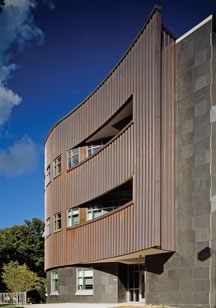
CILIT provides students and faculty with:
- A fully integrated learning environment
- A highly accessible and visibly inviting gateway into campus
- Enclosed pedestrian pathway
- Group study rooms
- Wireless networking
- High-tech instructional classrooms
- Flexible labs and research spaces
Two main components are associated with CILIT: the John and Ruanne Opie Library (the addition to the Van Pelt Library) and the Kanwal and Ann Rekhi Computer Science Hall (the new computer science building).
Opie Library
Through extensive reorganization and renovation, the 50-year-old Van Pelt Library became an all-inclusive academic student center. (See Figure 2.) The library's major collections were relocated to the lower level of the building, on compact shelving. This move accommodates easy access and browsing of the collections while reserving the majority of the upper floors for individual and collaborative student work.
Figure 2. Entrance to Opie Library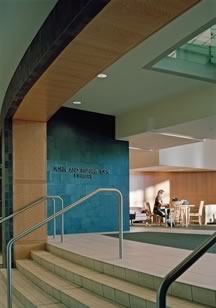
CILIT adds 44,000 square feet of new library space to 80,000 square feet of renovated space. Features include
- A 24-hour, 3,400-square-foot reading room
- A high-tech information wall providing the latest news about the weather, the world, the campus, and library activities
- 26 small group study rooms that accommodate up to 10 people each
- 50 public computers with wireless access
- A digital studio allowing students and faculty to integrate information from print, the Internet, sound recordings, or film into their work
- Two general computer classrooms
At the heart of this academic student center is the reading room (see Figure 3). This grand space is open 24 hours a day, allowing students to study and socialize-an especially welcome feature during winter weather at this northern Michigan campus. The reading room is enclosed by a curved glass curtain wall maximizing the amount of daylight entering the building.
Figure 3. Reading Room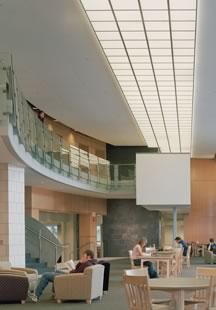
Rekhi Computer Science Hall
The new computer science hall provides the technology needed by the university's fastest-growing undergraduate degree program. It includes computer classrooms, distance education classrooms, and research laboratories.
- Four undergraduate general-purpose computer labs
- Two graduate study labs and special-purpose labs for:
- Cluster computing (linking multiple computers together to allow increased speed and memory)
- Robotics/artificial intelligence
- Computational science and engineering
- Distributed computing
- Graphics
- System administration, networking, and visualization
Occupying the interior of the computer science hall is the two-story student lounge. (See Figure 4.) This space, located along the pedestrian path, is commonly referred to as a "place for techies."
Figure 4. Student Lounge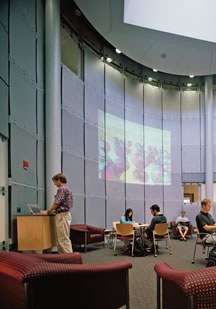
What Happens Here?
CILIT's six classrooms are reserved primarily for computer science education and research. Four are equipped for high-tech instruction, and two support distance education. (See Figure 5.) Students have access to a 24-hour study space, which also houses a high-tech information wall providing the latest news about the weather, the world, and campus and library activities. The center is also equipped with 26 small group study rooms accommodating more intensive learning environments, and the reading room is available 24 hours a day, five days a week.
Figure 5. CILIT Distance Education Classroom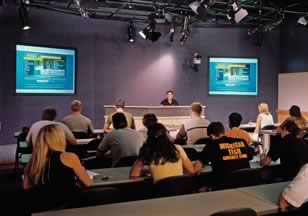
CILIT facilitates student interaction by providing collaborative study areas and social spaces for students, faculty, and staff. Small and large group study areas encourage formal and informal study gatherings. Both the student lounge and the integrated pedestrian pathway make it easier for students and staff to meet between classes, research, and study sessions.
How Is Technology Used?
The technology at CILIT is used for multimedia applications, distance learning, and student center learning and research projects. A digital studio allows students and faculty to integrate information from print, the Internet, sound recordings, or film into their work.
The center supports wireless and wired high-speed network access (http://www.RoverNet.mtu.edu/). A raised floor system allows for future technological upgrades and changes. Current technology used in the center, primarily in teaching labs in distance education spaces, includes:
- Sound systems with wireless microphones
- DVD/video tape recorders/players
- Touch-screen control system
- Video projectors
- Video camera and document camera
- Overhead projectors
- Tablet PCs
- Recording/streaming/Webcasting of presentations
- Videoconferencing
- Digital cameras
What Makes the Space Successful?
The new center is visible from a main highway thoroughfare-a prime location on campus. The oversized, curved-glass, south-facing wall of the library provides a welcoming window into the university.
In a place that can receive up to 100 inches of snow during the month of January alone, students can now work outside their dorm rooms at any hour and enjoy constant access to electronic media and the Internet. All the student spaces along the enclosed campus route are available 24 hours a day, seven days a week, for both group and individual learning.
Today, Phase 1 of an enclosed 100-foot pedestrian pathway unites the Opie Library (the addition to the existing Van Pelt Library) and the Rekhi Computer Science Hall, connecting all three facilities that make up CILIT. When completed as part of a separate physics and math building project, an enclosed pedestrian pathway will integrate all of the facilities on campus, including the dormitories. This will enable students to avoid having to venture out into frigid winter conditions.
What Principles Were Behind the Design?
Key principles influenced the design of CILIT, from the concept of supporting self-directed study to a desire to provide an attractive window into the university.
- Self-directed study: The major design principle was to enable student learning and self-directed study, building an environment for students to use as they see fit. Students can use CILIT at any time, whether 3:00 p.m. or 3:00 a.m.
- Academic learning center: The design in many ways is a repurposing of the library as the academic learning center for MTU, both for self-directed and group study. This contrasts with the library's former purpose as a center of knowledge.
- Integration: The center was created with distinct functions-as libraries and a computer science facility-that now function as an integrated learning environment for both formal and informal learning.
- Accessibility: To make the learning environment more convenient for students, it was important to link the learning environments of the Opie Library and Rekhi Computer Science Hall. Particularly in bad weather, students are disinclined to travel from one location to another. The accessibility of Opie Library and Rekhi Hall via a second-story pedestrian clearspan bridge makes it easy for students to get from one place to another. Future phases will create an enclosed pedestrian pathway throughout campus.
- Visibility: Opie Library and Rekhi Hall provide a window on the university. Even those just entering campus from the highway see a welcoming image of the university's spaces.
What Is Unique or Noteworthy?
The project is particularly well-aligned with university's four goals:
- To create an integrated learning center that allows students to gather knowledge from multiple media and bring it to their desktops.
- To create a new image or "front door" for the city side that visually expresses the energy of the university's students. The highway façade of the library addition and the computer science building align to strengthen and define the southern edge of the campus.
- To provide a facility tailored to the environment. This is done with the linking of the campus-wide enclosed pedestrian walkway, which started with the linking of the library and new computer science building.
- To recognize the project's donors. The project's two major donors-MTU alumni Kanwal Rekhi and John Opie-wanted an integrated learning environment that successfully connected two separate programmatic facilities. At the same time, the donors wanted a facility that encouraged the connection of all students, faculty, and staff.
About the Author
Paul Urbanek is vice president of design for SmithGroup.